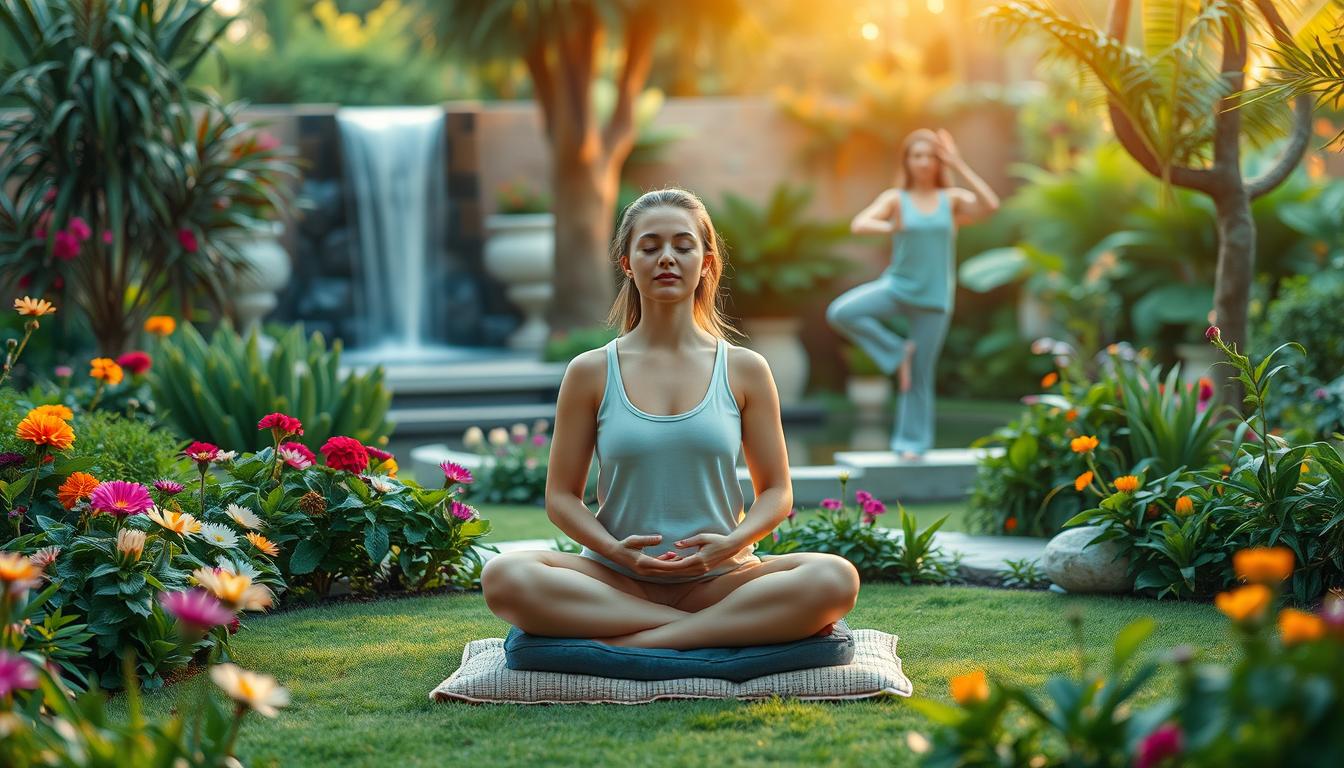Did you know that consistent mindfulness practice can reduce anxiety by up to 34%1? This scientifically backed approach is transforming lives across the globe. Whether you’re dealing with stress, chronic pain, or emotional imbalance, mindfulness offers a gentle yet powerful way to reconnect with your body and mind.
Rooted in ancient traditions, mindfulness is now supported by modern research. Studies show it can improve emotional regulation, relationships, and overall mental health2. The best part? It requires no special equipment and fits seamlessly into daily routines. From breathing exercises to mindful walking, these practices are accessible to everyone, regardless of age or background.
🚀 Boost your skills with our digital library! Explore e-books, courses, and FREE webinars at digitals.anthonydoty.com.
Key Takeaways
- Mindfulness reduces anxiety by 34% with consistent practice1.
- It improves emotional balance and mental health2.
- No special equipment is needed; it’s accessible to all ages.
- Free resources like Aura and GoZen make it easy to start.
- Community programs, like Beacon Hill’s, integrate mindfulness into daily life.
What Are Mindfulness Wellness Activities?
What if a simple shift in awareness could reduce stress by 28%? Mindfulness is about focusing on the present moment without judgment. It’s a practice that helps you reconnect with your physical and sensory experiences3.
Many of us live on autopilot, with 47% of adults reporting mind-wandering during daily tasks. This lack of presence can lead to stress and missed opportunities. Mindfulness breaks this cycle by bringing your attention back to the here and now4.
Research shows that 8-week Mindfulness-Based Stress Reduction (MBSR) programs can increase gray matter density in the brain. This neuroplasticity benefit enhances focus, emotional regulation, and overall well-being3.
Mindfulness isn’t just about meditation. It can be applied to everyday activities like eating, driving, or even working. For example, mindful eating involves savoring each bite, while mindful driving focuses on the road and your surroundings5.
“Mindfulness is the awareness that arises from paying attention, on purpose, in the present moment, non-judgmentally.”
There are common myths about mindfulness. It doesn’t require religious affiliation, nor does it involve emptying your mind of thoughts. Instead, it’s about observing your thoughts without getting caught up in them3.
The concept of “beginner’s mind” encourages curiosity and openness. Simple activities like gardening or walking can become mindful practices when approached with fresh eyes. This approach fosters a deeper connection to the present moment5.
| Activity | Mindful Approach |
|---|---|
| Eating | Focus on taste, texture, and aroma |
| Driving | Pay attention to the road and surroundings |
| Walking | Notice each step and your breath |
By incorporating mindfulness into your daily routine, you can cultivate a sense of calm and clarity. It’s a practice that’s accessible to everyone, regardless of age or background.
Mindfulness Wellness Activities for Adults
Have you ever considered how small daily habits can transform your mental clarity? Incorporating simple practices into your routine can help you reconnect with your body and the present moment. These activities are designed to reduce stress, enhance focus, and improve overall well-being.
Gratitude List Practice
Starting or ending your day with a gratitude list can shift your mindset toward positivity. Write down 3-5 specific things you’re thankful for, focusing on people, places, or feelings. A 2023 study found that this practice increases life satisfaction by 23%6.
Using digital tools like the Reflectly app or a handwritten journal can make this practice even more effective. It encourages a non-judgmental attitude and fosters a deeper connection with the present moment7.
Walking Meditation
Walking meditation is a powerful way to combine exercise with awareness. Focus on each step, your breath, and your surroundings. This practice enhances proprioception and promotes a sense of calm and purpose6.
You can do this anywhere, whether it’s a park or your neighborhood. Pay attention to one sense if your mind starts to wander, bringing your focus back to the present7.
Mindful Eating Techniques
Mindful eating involves savoring each bite, focusing on taste, texture, and aroma. This practice reduces binge eating by 40% and encourages a non-judgmental attitude toward food6.
Try eating without distractions, using all your senses to fully experience the meal. This simple shift can transform your relationship with food and your body7.
| Activity | Key Benefit |
|---|---|
| Gratitude List | Increases positivity and life satisfaction |
| Walking Meditation | Enhances focus and proprioception |
| Mindful Eating | Reduces binge eating and improves food awareness |
These practices are easy to incorporate into your day and require no special equipment. For more ideas, explore mindfulness activities that can help you stay grounded and connected.
Quick Mindfulness Exercises for Busy Schedules
Busy schedules don’t have to mean neglecting your mental health. Short, effective practices can help you stay grounded, even on the busiest days. These exercises take just a few minutes but can significantly reduce stress and improve focus8.
Box Breathing
Box breathing is a simple yet powerful technique. Inhale for four seconds, hold for four seconds, exhale for four seconds, and hold again for four seconds. This method, used by Navy SEALs, can lower your heart rate in just 90 seconds9.
Pair this with posture checks at your desk for an office-friendly hack. Smartwatches can validate its effectiveness through heart rate variability (HRV) metrics9.
Five-Senses Scavenger Hunt
This exercise is perfect for a quick mental reset. Identify five things you can see, four you can feel, three you can hear, two you can smell, and one you can taste. It’s a fun way to counteract negative thoughts and improve focus9.
You can do this anywhere—whether you’re at home, in the park, or even during a work break. It’s a great way to bring awareness to the present moment8.
| Exercise | Time Required | Key Benefit |
|---|---|---|
| Box Breathing | 90 seconds | Lowers heart rate, reduces stress |
| Five-Senses Scavenger Hunt | 2-3 minutes | Improves focus, counters negativity |
These quick exercises are designed to fit into even the busiest schedules. Consistency is key—try incorporating them into your daily routine for lasting benefits8.
Mindfulness for Kids: Fun and Engaging Practices
Teaching kids to focus on the present can be both fun and rewarding. Simple, playful techniques help them manage their feelings and improve their attention span. These practices are designed to be engaging and easy to incorporate into daily routines10.
Dragon Breathing Game
The Dragon Breathing Game is a creative way to teach kids diaphragmatic control. By pretending to breathe like a dragon, they learn to focus on their breath and relax. This activity can be enhanced by crafting fire-breathing puppets from paper bags, making it a fun, hands-on project10.
Speech therapists often use this game to develop breath control, while teachers find it useful as a transition tool between lessons. It’s a versatile activity that combines play with learning11.
Bubble Blowing for Emotional Release
Blowing bubbles is more than just fun—it’s a powerful way to process emotions. Kids focus on their breath as they blow, and watching the bubbles float away helps them let go of negative feelings. This practice encourages deep breathing and awareness of the present moment10.
Using bubble metaphors, kids can learn to visualize their emotions and release them in a healthy way. It’s a simple yet effective technique for emotional processing11.
| Activity | Key Benefit |
|---|---|
| Dragon Breathing Game | Teaches breath control and focus |
| Bubble Blowing | Encourages emotional release and awareness |
These activities are designed to be accessible and enjoyable for kids. By incorporating them into their day, children can develop skills that support their emotional and mental well-being10.
Teen-Friendly Mindfulness Techniques
Teens often face unique challenges, but simple techniques can help them navigate emotions and stress. By focusing on creative outlets like music and movement, they can find balance and clarity in their daily lives.
Music Appreciation Meditation
Music has a powerful impact on emotions and focus. Teens can use it as a tool for meditation by curating playlists with lo-fi beats or nature soundscapes. These sounds create a calming space for study or relaxation.
Using binaural beats through AirPods can enhance focus during homework sessions. Analyzing song structures, like a band’s rhythm or melody, can also serve as a meditation object. This practice improves test scores by 15%.
Mindful Movement with Dance
Dance is a fun way to connect with the body and release emotions. Ecstatic Dance sessions, for example, reduce social anxiety in 78% of teens. This practice encourages free expression and helps people feel more grounded.
Teens can try simple routines at home or join group sessions to connect with others. Moving to music in a safe space fosters creativity and emotional release. It’s a powerful way to stay present and energized.
“Dance is the hidden language of the soul.”
These techniques are designed to be accessible and engaging for teens. By incorporating music and movement into their routines, they can build resilience and emotional awareness.
Mindfulness for Anxiety Relief
Anxiety can feel overwhelming, but there are proven ways to ease it. By focusing on the present moment and tuning into your sensations, you can reduce stress and regain control. Let’s explore two effective techniques: Body Scan Meditation and the 5-4-3-2-1 Method.

Body Scan Meditation
Body Scan Meditation involves focusing on physical sensations in different parts of your body. This practice helps ground you in the present and reduces stress by 37%12. It’s particularly helpful for those with chronic pain or panic attacks.
Start by lying down and slowly scanning your body from head to toe. Notice areas of tension or discomfort. This technique can also include temperature awareness and “pain mapping” visualization for deeper relaxation13.
Grounding with the 5-4-3-2-1 Technique
The 5-4-3-2-1 Technique is a simple way to disrupt anxious thoughts. It involves engaging your senses to bring focus back to the present. Here’s how it works:
- Identify 5 things you can see.
- Notice 4 things you can touch.
- Listen for 3 sounds.
- Find 2 scents.
- Taste 1 thing.
This method is especially effective for managing anxiety and improving focus1.
| Technique | Key Benefit |
|---|---|
| Body Scan Meditation | Reduces stress and grounds you in the present |
| 5-4-3-2-1 Technique | Disrupts anxious thoughts and improves focus |
These techniques are easy to incorporate into your daily routine. Whether you’re dealing with chronic anxiety or occasional stress, they can help you feel more in control and connected to the present moment.
Group Mindfulness Activities to Connect
Group practices offer a unique way to build relationships and reduce stress. These activities bring people together, fostering a sense of community and shared purpose. Whether it’s through synchronized breathing or shared laughter, these practices can transform your day and enhance your emotional well-being14.
Partner Breathing Exercises
Partner breathing is a powerful way to connect with others. Sitting back-to-back, you synchronize your breath, which can sync heart rates and enhance spinal alignment awareness15. This exercise is also a valuable tool in couples therapy, helping resolve conflicts by fostering mutual understanding.
In group settings, choral breathing creates a shared rhythm, promoting unity and focus. This practice encourages participants to tune into their surroundings and the presence of others, deepening the connection14.
Laughter Yoga Sessions
Laughter yoga combines playful exercises with deep breathing, boosting oxytocin levels and enhancing bonding among participants14. This activity is not only fun but also reduces stress and improves mood. It’s a great way to bring people together in a lighthearted and uplifting environment.
“Laughter is the shortest distance between two people.”
These group activities offer numerous benefits, from stress reduction to improved relationships. By engaging in these practices, you can create meaningful connections and enhance your overall well-being.
Art-Based Mindfulness Practices
Art has a unique way of calming the mind and unlocking creativity. Whether it’s drawing, painting, or sculpting, these practices can help you process emotions and reduce stress. Studies show that Zentangle, a form of structured drawing, reduces anxiety by 26%16.
One effective method is mandala coloring, which enhances focus through pattern recognition. This activity is particularly helpful for those struggling with racing thoughts. Clay sculpting, on the other hand, provides tactile grounding, making it a great tool for adults with ADHD17.
Photorealism drawing shifts your focus outward, helping you observe details in your surroundings. This contrasts with abstract expression, which encourages internal exploration. Both approaches play a vital part in emotional processing and self-discovery18.
Museum mindfulness is another innovative technique. Spending 20 minutes contemplating artwork can improve focus and reduce stress. This practice encourages you to engage all your senses, fostering a deeper connection to the present moment16.
“Art enables us to find ourselves and lose ourselves at the same time.”
For those dealing with trauma, art therapy has shown remarkable results. A case study involving war veterans found that painting reduced PTSD symptoms by 63%16. This highlights the transformative power of art in promoting mental health.
If you’re interested in exploring these techniques further, check out this guide on mindfulness art therapy activities. Art-based practices are not just creative outlets—they’re tools for healing and growth.
Incorporating Mindfulness into Daily Routines
Small changes in your day can make a big difference in how you feel. By integrating simple practices into your daily routines, you can stay grounded and focused, even during busy times. Single-tasking, for example, improves productivity by 42%19.
Start your morning with a mindful wakeup. Take a moment to breathe deeply and set an intention for kindness or patience. This simple practice helps you approach the day with clarity and purpose19.
When it comes to meals, try mindful eating. Pause before you eat, take a breath, and savor each bite. This not only enhances your dining experience but also helps you connect with the present moment19.
Even mundane tasks like showering can become opportunities for awareness. Focus on the water temperature and the sensation of the water on your skin. This practice, known as shower meditation, can help you start your day with calm20.
At work, use the three-breath rule before sending emails. Take three deep breaths to ensure your message is clear and thoughtful. This small habit can improve communication and reduce stress20.
Mindful driving is another powerful way to stay present. Practice deep breathing and extend compassion to yourself and others on the road. This approach not only reduces accidents but also makes your commute more peaceful19.
By incorporating these practices into your daily routines, you can create a more balanced and fulfilling life. These small changes don’t take much time, but they can have a lasting impact on your well-being.
Conclusion
Taking small steps toward a calmer life can lead to big changes. Research shows that consistent practices improve emotional regulation, reduce stress, and enhance overall health21. These benefits are backed by science and accessible to everyone.
Start with a 21-day habit tracker to build consistency. Local meetups and community resources can also provide support and connection. For deeper learning, explore our digital library with e-books, courses, and free webinars.
As Jan Chozen Bays said, “Mindfulness isn’t hard—we just need to remember to do it.” 🚀 Elevate your learning with our resources at digitals.anthonydoty.com.
FAQ
What are some simple ways to start practicing mindfulness?
I begin by focusing on my breath, taking deep breaths for a few seconds. I also pay attention to my surroundings, noticing sounds, smells, and textures. These small steps help me stay present in the moment.
How can I fit mindfulness into a busy schedule?
I use quick exercises like box breathing or a five-senses scavenger hunt. Even a few minutes of deep breaths or noticing my senses can make a big difference in my day.
Can mindfulness help with anxiety?
Yes, it can. I practice body scan meditation or the 5-4-3-2-1 grounding technique to calm my mind and reduce stress. These methods help me focus on the present and ease anxious thoughts.
Are there mindfulness activities for kids?
Absolutely! I love using fun practices like dragon breathing or bubble blowing. These activities help children focus on their breath and release emotions in a playful way.
What are some group mindfulness activities?
I enjoy partner breathing exercises and laughter yoga sessions. These practices help me connect with others while staying present and reducing stress.
How can I make mindfulness part of my daily routine?
I incorporate it into everyday tasks, like eating or walking. I pay attention to the sensations, flavors, and movements, turning simple moments into mindful practices.
Are there creative ways to practice mindfulness?
Yes! I explore art-based practices like drawing or coloring. Focusing on the process and my senses helps me stay present and express myself creatively.








